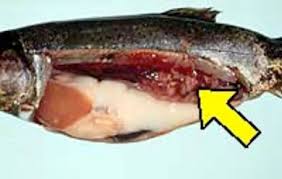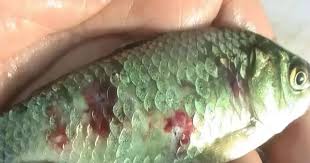Fish disease is an unhealthy fish body condition. It is the departure from the normal wholesome state of the fish. It is condition of discomfort or sickness which can lead to reduction in the normal physiological activities and development of the fish.
Catfish production involves many risks and has been described as one of the most management intensive forms of farming in addition to the high entry cost.
As a result of the increased artificial feeding of the heavily stocked fish, metabolic activity of the fish is increased, thus increasing the levels of organic wastes and toxic compounds within the ecosystem.
Algae, bacteria and other microorganisms begin to grow. The ponds ecosystem is more difficult to maintain than cages and pens in natural water bodies therefore, the pond system eventually becomes imbalance and cannot be maintained and organic wastes build up to toxic levels (such as ammonia and nitrites) constituting massive blooms of algae growth. The dominant type of algae that is prevalent is blue-green algae which are the major cause of off-flavours in fish.
On a general note, fish diseases can be categorised as infectious diseases, parasitic diseases, nutritional diseases and environmental diseases of which environmental, parasitic and bacterial infections-a form of infectious diseases are most prevalent in the tropics.
This unit shall look into the possible ways of controlling the adverse effects of poor fish environment (water quality) and treatment of bacterial infections through medication
1. Effect of Microbial Attack on Fish Production
The “low-intensity” management practices used prior to the 1980’s generally resulted in good pond water quality and lower overall stress on fish populations. Lower fish densities also meant less efficient transmission of disease organisms.
Over the years, stocking and feeding rates steadily increased and producers adopted a multiple-batch cropping system wherein new populations of fingerlings were stocked into ponds with existing populations of larger fish.
These production practices lead to the emergence of infectious diseases as the primary limiting factor in catfish production, and disease outbreaks are not uncommon even on well-run facilities.
About forty-five percent of inventory losses on catfish fingerling farms are attributable to infectious diseases. Corresponding survey data for food-sized fish are lacking.
Of the overall catfish losses caused by infectious disease, approximately sixty percent are the result of single or mixed bacterial infections, thirty percent result from parasitic infestation, 9 percent from fungal infections, and one percent is of viral etiology. Multiple or mixed infections often occur in pond raised channel catfish making treatment decisions difficult.
Economic losses resulting from infectious diseases are difficult to quantify because record keeping varies among farmers and many diseases go unreported. Nevertheless, infectious disease is believed to cost producers many millions of dollars in direct fish losses each year.
In addition, infectious diseases influence profitability by increasing treatment costs, reducing food consumption by fish, increasing feed conversion ratios, and causing harvesting delays. Fish-eating birds may also be attracted to ponds with sick and dying fish causing further losses.
There are several disease syndromes for which the etiology remains in question, such as channel catfish anemia (CCA), which has also been referred to as no blood disease”. Another syndrome is visceral toxicosis of catfish (VTC), believed to be caused by a toxin.
Once a disease outbreak occurs, effective health management requires three basic steps: problem identification, diagnosis, and corrective management-all of which must be performed in a timely manner to avoid further losses.
Whenever multiple factors contribute to the disease process, it makes the diagnosis more difficult and often complicates corrective management.
2. Use of Medicated Feed in Catfish Production
Pond-raised catfish are the most popular species of food fish grown in the southeastern United States. Because of crowding and associated stressors encountered in modern aquaculture, they are more susceptible to disease than free-ranging animals.
Bacterial disease is frequently the cause of death of catfish, though often secondary to other problems such as poor water quality or excessive parasitism. Medicated feeds can be used to control bacterial disease. However, the results of treatment may only be temporary unless underlying problems are also corrected.
3. Bacterial Disease in Fish Production

Bacteria are tiny, single-celled organisms which live in the water, the sediments, on the surface and in the intestines of fish. Most bacteria are beneficial and essential for life. They help to digest foods and produce vitamins, as well as break down ammonia and organic debris in the environment.
A few bacteria are considered opportunistic pathogens. These bacteria are always present and usually cause no problem. However, under certain conditions they can cause disease in fish.
Common examples of opportunistic pathogens which can cause disease and death of catfish include Aeromonas sp., Pseudomonas sp., and Flexibacter sp.
A few bacteria are considered obligate pathogen, which means they are likely to be the sole cause of disease rather than a secondary problem. There is some speculation that Edwardsiella ictaluri may be an obligate pathogen.
Separate fact sheets on the bacterial diseases mentioned above are available. Aeromonas and Pseudomonas cause very similar diseases often characterized by large ulcers on the side of the fish, distended abdomen (dropsy), and exopthalmia (popeye). Flexibacter columnaris causes a disease called “columnaris disease” or “saddleback disease.” It is usually an external problem which begins by loss of colour (paleness) along the back of the fish. As the disease progresses, large ulcers may develop. Mixed infections with Aeromonas and Pseudomonas are common in advanced cases.
Poor management practices are often the cause of these infections. For example, rough handling damages the skin and mucus of the fish and can result in secondary bacterial infections.
Control of these infections often requires the use of medicated feed. Because these infections are usually opportunistic, it is sometimes possible to control the spread of the bacterial infections by correcting management problems that preceded disease outbreak (e.g., excessive parasitism or poor water quality).
Edwardsiella ictaluri is a bacterium considered by some to be an obligate pathogen. This may not be precisely true, but this organism without doubt causes the most significant bacterial disease of channel catfish-enteric septicemia of catfish, or ESC. Some producers refer to ESC as “hole-in-the-head disease.” It frequently causes ulcers in the middle of the skull of fingerlings, just above the eyes.
Medicated feed is almost always recommended to control ESC outbreaks. Catfish which are becoming sick with ESC often stop eating so early diagnosis and treatment is essential to minimize losses.
Read Also: Nutritional Requirements of Fishes for Optimum Performance
Read Also: Products That Can Be Derived From Marine Debris

